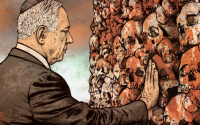Common Dreams / Published on Sunday, December 26, 2004 by the International Herald TribuneAdam Hochschild
Congolese often say, "We'd be so much better off if we weren't so rich." The great wealth of this unhappy territory at the center of Africa has long attracted foreigners. Centuries ago, Atlantic slave traders anchored in the mouth of the Congo River and filled their ships with captives from the interior. Today's predators are African armies and European and American corporations hungering for mineral wealth. That greed has driven the civil war that has ranged intermittently over the country for the last six years, and which in recent weeks has heated up again.
This month, the International Rescue Committee estimated that there have been 3.8 million deaths in the six-year conflict. This is the largest war toll anywhere since World War II, and with 31,000 people still dying every month, no end is in sight.
The territory has a long history of plunder. After the slave trade ended, ivory and rubber made it the bloodiest European colony in Africa, the real-life setting for Joseph Conrad's "Heart of Darkness." For 23 years, it was the private property of King Leopold II of Belgium, who made a huge fortune by turning most adult male Congolese into slaves to gather wild rubber. His private army worked hundreds of thousands of men to death and shot down 20 years of uprisings. Just as today, disease took the greatest toll, ravaging a traumatized, half-starving people, many of whom hid unsheltered in the rain forest. Demographers estimate that the population was cut by half - a loss of some 10 million people - during Leopold's rule and its immediate aftermath.
In 1908, the Belgian government took over the colony, and gradually the carnage slowed and stopped. But, as in much of colonial Africa, forced labor remained, and mining profits flowed overseas.
For most of the years since Congo's abrupt independence in 1960, the dictator Mobutu Sese Seko ruled the country with U.S. support and with more than $1 billion in U.S. aid. With his remote marble palace, his love of pink Champagne and chartered Concordes, and his luxury homes dotted around Europe, Mobutu and his entourage plundered the country of an estimated $4 billion before being overthrown in 1997.
Afterward, Congo slid quickly into war. Seeing a huge, resource-rich country with no functioning government, neighboring countries joined in dividing the spoils. At various points, the armies of seven of them - most importantly Rwanda, Uganda, and Zimbabwe - have had troops on Congo's soil. The Rwandan army stole natural resources worth $250 million in 1999 and 2000 alone, according to a UN report. Even after most foreign troops went home, their commanders retained lucrative mineral concessions and an ever-changing web of alliances: with the country's nominal national government, with three main rebel groups in the east, with local warlords, and with a wide variety of foreign corporations.
These companies have been eagerly buying Congo's diamonds, gold, timber, copper, cobalt and coltan. Eastern Congo, scene of the new fighting, has more than half the world's supply of coltan, which is used in computer chips and cellphones, and has occasionally sold for as much, per ounce, as gold. The multisided war is driven by greed, not ideology; fighting sometimes shifts location with the rise and fall of commodity prices.
Among the many corporations that have been involved are America Mineral Fields, once headquartered in former President Bill Clinton's hometown of Hope, Arkansas, and the Barrick Gold Corporation of Canada, which until recently listed former President George H. W. Bush on its international advisory board. Few of these companies, the rebel militias or Congo's African neighbors have much interest in ending the country's Balkanization. They benefit far more from a cash-in-suitcases economy than they would from a taxed and regulated one that would tightly control natural resources.
Whatever else it might do, the world needs to pay more attention to how anarchic civil wars like the one in Congo are fueled by minerals. Recognizing how diamonds have helped drive the conflicts in Angola, Liberia and Sierra Leone, more than 50 nations, including the United States, recently agreed to cease trading in "conflict diamonds." The pact is relatively toothless, but it set a precedent: A recent World Bank study suggested that if conflict diamonds can be outlawed, why not conflict gold and conflict coltan?
Agreements like this could begin to slash the funding for Congo's warmakers. Such pacts would be difficult to enforce, but for many years, so was the ultimately successful ban on the Atlantic slave trade.
Adam Hochschild is the author of ''King Leopold's Ghost: A Story of Greed, Terror and Heroism in Colonial Africa.''






